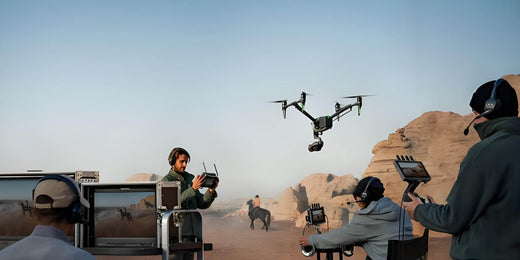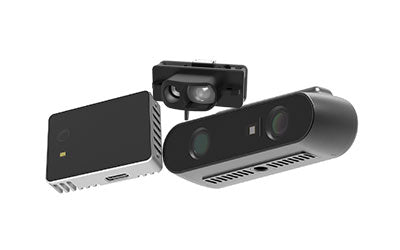Drones with ToF 3D Depth Cameras: Precision Sensing Meets Creative

Unlocking Precision with Drones and ToF 3D Depth Cameras
what is tof?
ToF (Time of Flight) is a distance measurement technology that works by emitting light pulses and measuring the time it takes for the light to reflect off an object and return to the sensor. It calculates the distance between the object and the sensor. ToF sensors are commonly used in depth sensing, 3D imaging, and drone obstacle avoidance, offering high precision and fast response.
With the rapid advancement of drone technology, drones equipped with 3D depth cameras have opened new possibilities for photography, film production, mapping, and surveillance. Especially the application of ToF (Time-of-Flight) 3D depth cameras, which endow drones with precise spatial awareness, allows them to capture highly detailed images and achieve 3D perception in complex scenes. This combination enhances the drone's ability to shoot in dynamic environments and marks a revolutionary breakthrough in automated, intelligent photography.
How ToF 3D Depth Cameras Work
ToF 3D depth cameras emit light pulses and measure the time it takes for the light to reflect back from objects to calculate the distance. Each pixel independently collects depth information, creating images that contain both the 3D structure and distance data of objects. Unlike traditional cameras, ToF camera sensors capture not only the surface light and shadow information but also the spatial depth data, generating complete 3D images.
When a ToF 3D depth camera is integrated into a drone, the drone can collect real-time depth data and high-definition images during flight. This provides photographers with richer creative materials while enhancing the drone's ability to perceive its environment for automated flight, improving functions like drone avoid obstacles.
Key Advantages of Drones with ToF 3D Depth Cameras
-
High-Precision Spatial Perception and 3D Imaging
The core advantage of a ToF 3D depth camera is its ability to provide precise depth information. This allows the drone not only to capture 2D images but also to create 3D models of objects and scenes, resulting in stronger dimensionality in the footage. When capturing complex structures, natural landscapes, or dynamic scenes, the depth camera provides essential data for 3D modeling, special effects, and immersive experiences.For drone photographers, the ToF camera sensor can accurately determine the distance, size, and shape of the subject, allowing the adjustment of shooting angles to avoid obstructions and misalignment. For instance, when shooting large landscapes like mountains, canyons, or urban buildings, the drone can use depth data to plan the optimal flight path and create layered imagery.
-
Smart Obstacle Avoidance and Auto-Tracking
The ToF 3D depth camera not only enhances the drone's photography capabilities but also improves its safety during smart flight. By gathering real-time depth information from the environment, the ToF sensor can detect nearby obstacles and guide the drone to adjust its flight path to avoid collisions, ensuring the indoor drone functions well in enclosed spaces.Additionally, the ToF camera provides accurate depth data for the drone’s auto-tracking functions. When filming dynamic videos or tracking moving objects, the ToF camera can measure the position and distance of the subject in real-time, allowing the drone to flexibly adapt to fast-changing scenes while maintaining stable tracking. This is particularly useful in sports or outdoor adventure shoots, ensuring the drone can fly smoothly and consistently record the moving subject even in complex terrains.
-
Enhancing VR/AR Experiences
The high-precision depth data generated by the ToF 3D depth camera is crucial for creating realistic 3D scenes in virtual reality (VR) and augmented reality (AR) applications. The panoramic and 3D data captured by the drone's ToF camera can be directly used to build environments for VR, greatly improving the realism and immersion of the scenes.In the field of AR, the ToF camera provides dynamic depth information, enabling digital content to seamlessly integrate with real-world environments. For instance, in architecture, virtual tourism, or game production, the 3D depth images from the ToF camera offer more interactive experiences by accurately overlaying virtual elements into the real world.
-
Accurate Mapping and Modeling in Dynamic Environments
For mapping and terrain modeling, the combination of a ToF 3D depth camera and drones provides more efficient and accurate tools for geographic information systems (GIS) and 3D map creation. The ToF sensor allows for quick, precise scanning of vast terrain areas, generating 3D models for analysis and planning.The drone's ability to fly in dynamic environments, combined with the real-time depth data collected by the ToF camera, helps engineers measure the 3D structures of buildings, bridges, roads, and more with precision. This reduces the workload of traditional surveying while improving accuracy, making it particularly useful for disaster recovery, environmental assessment, and urban planning.
Applications of Drones with ToF 3D Depth Cameras
-
Film and Creative Photography
In film production, the use of drones with ToF 3D depth cameras opens new possibilities for special effects and scene creation. The ToF camera captures depth information in dynamic scenes, providing precise data for 3D effects in post-production. Directors and production teams can use the 3D data captured by drones to create realistic CGI scenes and add virtual elements more flexibly during editing.Additionally, ToF 3D depth cameras can capture rich panoramic images, enhancing viewer immersion, especially when shooting natural landscapes or outdoor adventure films, offering more realistic environmental details.
-
Architecture and Engineering Surveying
In the field of architecture, the 3D modeling capabilities of ToF cameras on drones are widely used for building surveys, progress monitoring, and construction inspection. The drone’s flexible flight capabilities and the ToF camera’s precise scanning allow architects and engineers to quickly acquire 3D data from construction sites, generating complete building models for design evaluation and improvement.The real-time depth data generated by the ToF 3D camera can also be used for facade inspection, crack detection, and construction quality control, helping construction managers monitor and make decisions more efficiently.
-
Security and Surveillance
In the security field, drones equipped with ToF 3D depth cameras bring a new dimension to surveillance systems. Drones can patrol large areas, scanning the 3D structure of the environment in real-time and generating accurate depth images. For large-scale security monitoring, the ToF camera’s 3D perception helps drones detect potential threats, automatically identifying and tracking targets to improve security.In sensitive areas or specific scenarios, drones equipped with ToF cameras can dynamically scan and autonomously patrol, ensuring comprehensive, full-coverage surveillance.
-
Cultural Heritage Protection and 3D Scanning
In the field of cultural heritage protection, drones equipped with ToF cameras can efficiently scan monuments, sculptures, and architectural ruins, generating detailed 3D models. This data helps heritage experts conduct digital preservation and restoration while minimizing direct contact and damage to artifacts.Drones can easily access difficult-to-reach places, performing comprehensive 3D scans of cultural heritage sites, providing detailed data for research and exhibition purposes.
Conclusion: The Future of ToF 3D Depth Cameras and Drone Integration
The introduction of ToF 3D depth cameras has added a new dimension to drone photography, expanding its applications across various industries. From film production to architectural surveying, from security monitoring to cultural heritage protection, the ToF camera’s 3D perception allows drones to accurately capture environmental depth and structure, enhancing both image quality and data processing precision. As ToF technology continues to evolve, future drone photography will become more intelligent, providing creators, engineers, and scientists with powerful tools, driving continuous innovation in drone applications.
Synexens 3D Of RGBD ToF Depth Sensor_CS30
Our professional technical team specializing in 3D camera ranging is ready to assist you at any time. Whether you encounter any issues with your TOF camera after purchase or need clarification on TOF technology, feel free to contact us anytime. We are committed to providing high-quality technical after-sales service and user experience, ensuring your peace of mind in both shopping and using our products
-
で掲示されます
CS30






